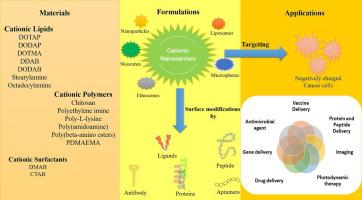当前位置:
X-MOL 学术
›
Adv. Colloid Interface Sci.
›
论文详情
Our official English website, www.x-mol.net, welcomes your feedback! (Note: you will need to create a separate account there.)
Cationic nanocarriers: A potential approach for targeting negatively charged cancer cell
Advances in Colloid and Interface Science ( IF 15.6 ) Pub Date : 2024-04-22 , DOI: 10.1016/j.cis.2024.103160 Monika Vishwakarma , Poornima Agrawal , Sakshi Soni , Surbhi Tomar , Tanweer Haider , Shushil K. Kashaw , Vandana Soni
Advances in Colloid and Interface Science ( IF 15.6 ) Pub Date : 2024-04-22 , DOI: 10.1016/j.cis.2024.103160 Monika Vishwakarma , Poornima Agrawal , Sakshi Soni , Surbhi Tomar , Tanweer Haider , Shushil K. Kashaw , Vandana Soni

|
Cancer, a widespread and lethal disease, necessitates precise therapeutic interventions to mitigate its devastating impact. While conventional chemotherapy remains a cornerstone of cancer treatment, its lack of specificity towards cancer cells results in collateral damage to healthy tissues, leading to adverse effects. Thus, the quest for targeted strategies has emerged as a critical focus in cancer research. This review explores the development of innovative targeting methods utilizing novel drug delivery systems tailored to recognize and effectively engage cancer cells. Cancer cells exhibit morphological and metabolic traits, including irregular morphology, unchecked proliferation, metabolic shifts, genetic instability, and a higher negative charge, which serve as effective targeting cues. Central to these strategies is the exploitation of the unique negative charge characteristic of cancer cells, attributed to alterations in phospholipid composition and the Warburg effect. Leveraging this distinct feature, researchers have devised cationic carrier systems capable of enhancing the specificity of therapeutic agents towards cancer cells. The review delineates the underlying causes of the negative charge in cancer cells and elucidates various targeting approaches employing cationic compounds for drug delivery systems. Furthermore, it delves into the methods employed for the preparation of these systems. Beyond cancer treatment, the review also underscores the multifaceted applications of cationic carrier systems, encompassing protein and peptide delivery, imaging, photodynamic therapy, gene delivery, and antimicrobial applications. This comprehensive exploration underscores the potential of cationic carrier systems as versatile tools in the fight against cancer and beyond.
中文翻译:

阳离子纳米载体:靶向带负电荷的癌细胞的潜在方法
癌症是一种广泛传播的致命疾病,需要精确的治疗干预措施来减轻其破坏性影响。虽然传统化疗仍然是癌症治疗的基石,但其缺乏针对癌细胞的特异性,会对健康组织造成附带损害,从而产生不良反应。因此,寻求有针对性的策略已成为癌症研究的一个关键焦点。这篇综述探讨了利用新型药物输送系统开发创新靶向方法,以识别和有效地攻击癌细胞。癌细胞表现出形态和代谢特征,包括不规则形态、不受控制的增殖、代谢变化、遗传不稳定性和较高的负电荷,这些特征可作为有效的靶向线索。这些策略的核心是利用癌细胞独特的负电荷特征,归因于磷脂成分的改变和瓦尔堡效应。利用这一独特特征,研究人员设计了能够增强治疗剂针对癌细胞的特异性的阳离子载体系统。该综述描述了癌细胞中负电荷的根本原因,并阐明了使用阳离子化合物用于药物输送系统的各种靶向方法。此外,它还深入研究了用于制备这些系统的方法。除了癌症治疗之外,该评论还强调了阳离子载体系统的多方面应用,包括蛋白质和肽递送、成像、光动力疗法、基因递送和抗菌应用。这一全面的探索强调了阳离子载体系统作为抗癌及其他疾病的多功能工具的潜力。
更新日期:2024-04-22
中文翻译:

阳离子纳米载体:靶向带负电荷的癌细胞的潜在方法
癌症是一种广泛传播的致命疾病,需要精确的治疗干预措施来减轻其破坏性影响。虽然传统化疗仍然是癌症治疗的基石,但其缺乏针对癌细胞的特异性,会对健康组织造成附带损害,从而产生不良反应。因此,寻求有针对性的策略已成为癌症研究的一个关键焦点。这篇综述探讨了利用新型药物输送系统开发创新靶向方法,以识别和有效地攻击癌细胞。癌细胞表现出形态和代谢特征,包括不规则形态、不受控制的增殖、代谢变化、遗传不稳定性和较高的负电荷,这些特征可作为有效的靶向线索。这些策略的核心是利用癌细胞独特的负电荷特征,归因于磷脂成分的改变和瓦尔堡效应。利用这一独特特征,研究人员设计了能够增强治疗剂针对癌细胞的特异性的阳离子载体系统。该综述描述了癌细胞中负电荷的根本原因,并阐明了使用阳离子化合物用于药物输送系统的各种靶向方法。此外,它还深入研究了用于制备这些系统的方法。除了癌症治疗之外,该评论还强调了阳离子载体系统的多方面应用,包括蛋白质和肽递送、成像、光动力疗法、基因递送和抗菌应用。这一全面的探索强调了阳离子载体系统作为抗癌及其他疾病的多功能工具的潜力。



























 京公网安备 11010802027423号
京公网安备 11010802027423号